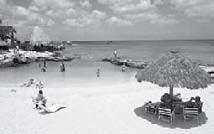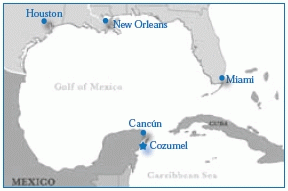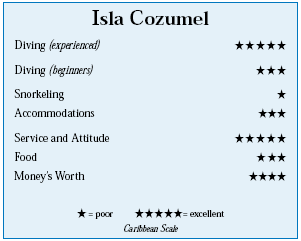Isla Cozumel, MexicoContents of this Issue: SMY Ondina, Raja Ampat, West Papua When You Decide To Go It Alone Younger, Newer and Female Divers Show More DCI Symptoms So How Many Divers Are There, Really Irrational Fear of Flashing Dive Computers Regulators: Two Recalls and NOAA's New Favorite Editorial Office: Ben Davison Publisher and Editor Undercurrent 3020 Bridgeway, Suite 102 Sausalito, CA 94965 recovering nicely from Hurricane Wilma from the July, 2007 issue of Undercurrent
Dear Reader: I’m a Cozaholic. I’ve taken three dozen trips to Cozumel in 33 years and still I’m compelled to return. For me, there’s no better season than spring; after El Nino and before hurricane seasons, it is not yet too hot or humid. Days are usually sunny and seas calm. I can depart from Baltimore in the morning and be absorbing nitrogen in Cozumel waters by early afternoon. It has the Caribbean’s best drift diving at the best value. Any diver can locate digs and food to his liking. Accommodations vary from the high-end InterContinental Presidente Resort and Spa, rebuilt after Wilma in 2005, to inexpensive places downtown. Eateries range from the upscale Wynston and La Cocay to mom-and-pop places serving delicious, cheap “comida corrida.” And there are the friendly attitudes, variety of dive sites, and generally excellent weather and scuba conditions. Clearing the airport in April was a breeze, less than 25 minutes. The drive to town was 10 minutes, although it can be a half-hour for those staying in the south. Just three hours after I landed, I was backrolling into 80- degree water for a meandering swim-thru at Palancar Caves.
With visibility well past 100 feet, it’s a good place for
intermediate divers
to get introduced to
walls, swim-throughs
and openings formed
by the fusion coral
heads, and Wilma
exposed even more.
I entered several
openings that deadended
but there
was ample room to
turn around easily.
Upon emerging from
a swim-through, I
spied a sizeable black grouper and green moray engaging in
cooperative hunting. The next dive was at Tunich, the Mayan term for a beheading stone. This site consistently delivers a rollicking roller-coaster ride and an odd wicked vertical current, and it didn’t disappoint. I shot past a tawny-toned, six-foot nurse shark festooned with remoras. As I floated north, a massive crab claw protruded from cement coral below me. A giant green parottfish, the color of corroding copper, chewed up the coral as it bullied its way down the reef. A fine first day of scuba. I dived with Liquid Blue because of its excellent customer service and orientation to more advanced divers. They had me diving before most of the Cozumel fleet had even gassed up. They also provided Worthington HP steel 120s and a willingness to visit more distant and challenging sites. The owners are Michaela, a pleasant but serious businessperson originally from Colorado, and her easygoing Mexican husband Roberto who likes to laugh and loves to dive. The Bonita Luna and Tara II were shaded and uncluttered with a small storage space beneath each seat. Having once been stranded off the far Yucatan when the engine on a single screw craft went south, I preferred the Bonita Luna as she had twin outboards. After my first day’s diving, I repaired to the Suites Bahia and my balcony room for $55 per night. It’s a block away from Liquid Blue’s shop, several blocks south of the main plaza, and just off the waterfront drag. Suites Bahia is a small, basic place but spotlessly clean. I had two large beds, a tiled bathroom, desk and a large closet with overhead storage. The small kitchen had a mid-sized fridge, sink and electric stove, but no cookware or utensils. The price included a modest continental breakfast but it wasn’t available until 7 a.m. so I usually missed it due to Liquid Blue boats’ early departure times. There was no bar or restaurant, and the only common area is the small lobby with a TV, vending machine and free Internet service. Everything a diver needs is right outside their door. Within a block were two dive shops, the American Discount Drug Store; a convenience store for snacks; a boutique eatery named Sorrisi that served a medium cup of gelato for $5 and wood-oven pizzas starting at $11; and a Pizza Hut for more pedestrian tastes. But I dined at the small loncherias, chicken and ribs places and taquerias that dot 30th Avenue east of downtown, where turistas mingle easily with locals. Nine assorted tacos and two orange sodas at El Pique (across from the old San Francisco market) set me back $10 with tip. Compare that to Wynston, where a small green salad with a vinaigrette dressing runs $5, and chicken Dijon with rice and grilled vegetables fetches $16. But being perched on top of the El Cantil Norte condos, Wynston does have a boffo view. And I must admit my most memorable meal was a Caesar salad, mixed seafood pasta fra diavolo and a nice bottle of red wine at Prima, a longtime favorite, for $25. I’ve never been a big fan of the storied Barracuda Reef because its visibility is sometimes so-so and the wicked, vertical currents can deplete gas in a hurry, but on this trip I enjoyed it thanks to the mild current and primo visibility. A big spotted eagle ray cruised the wall and allowed a long, close approach. So did several hawksbill turtles, one of which was munching a large hole into a barrel sponge. I drifted across an impressive aggregation of porkfish, schoolmasters and mahogany snappers, many sporting mating colors and shades, as if overcome by a spring fever of pheremonal frenzy. For surface intervals, I relaxed on the beach at Playa Azul, tranquil and pleasant although much of its sand had been Wilma’d away. San Juan in the north, a longtime favorite, reminded me why Cozumel is synonymous with drift diving. It’s a mid-depth reef with excellent visibility, and its vigorous, steady current let me cover lots of ground. Pre-Wilma, San Juan was loaded with hawksbill turtles, free-swimming morays and carpeted in vibrant coral but sadly is now a ghost of its former self. Finger corals now lay in skeletal heaps and only nascent algae regrowth peeked out. The high point was several triggerfish going about their mating and nesting behavior, oblivious to the death lying below them. Cozumel used to have a few nice snorkeling sites but they’ve also been badly damaged by Wilma. However, Dzul Ha, a small beach club south of the InterContinental Presidente, and Parque Chankanaab next door are the good bets. Liquid Blue offered two morning dives and one afternoon dive. The boat left between 7:30 and 8 a.m., with the first dive starting at 8:30. I backrolled in for my dives and got back in the boat via side ladder. Surface intervals were at one of the beach clubs. After the second dive, it was back into port for lunch, then the afternoon dive at 2 p.m. They supplied me with a mesh bag with my name on it for storing and toting gear. The crew set up my gear daily and rinsed and stored it each evening (except for wetsuits). With the exception of a very few dive operators, tank fills on Cozumel are done at a central facility; mine averaged 3,000 psi. Bottled water and big towels were onboard, but divers had to bring their own extras. Liquid Blue affords divers lots of freedom. Each day, they asked where I’d like to dive. Once divemasters Jorge and Roberto were satisfied with my competence and trustworthiness, they went along with relatively extreme dive profiles and pointed out great photo ops. This meant I could do deep sites and get profound perspectives on sites normally dived at shallower depths. Instead of the typical 120-foot depths at Maracaibo Deep, I once dropped to 200 feet. Santa Rosa Wall was far better at 150 feet than at 90 feet. That my dive buddy and I were the only customers for four of our six dive days only added to the feeling of freedom and personal attention. However, even on days with more divers, there was still plenty of space. Bright and early another morning, I wafted over Columbia Deep, a dive typically done at 70 to 100 feet that boasts massive coral heads rising 70 feet from the sea floor. There, I was stunned by an unanticipated display of sponge spawning. Bowl and basket sponges gave off smoky plumes of gametes. Barrel sponges, resembling top-loading washing machines overfilled with detergent, positively splooged. Snow-white spawn churned, frothed and spilled into the current. Spectacular.
Back in the agua, Dahlila, a low-profile shelf reef I dived at 40 feet, was still scoured and silted from Wilma. I hoped to find Cozumel’s splendid toadfish here, but not this time. I was amused by a pair of spotted scorpionfish locked in an obviously thorny relationship. Here also was my most salacious sighting -- three flamingo tongues extending their hermaphroditic gear, finding home and forming a ménage à trois that lasted longer than my gas. On this dive, my first stage sprung a leak, then my dive computer flooded and died. Liquid Blue provided replacements, did repairs on the spot and didn’t charge me a peso. Not surprisingly, a small, personal operation with oversized tanks and a willingness to go to the most distant dive sites at no premium charged more. While most Cozumel dive outfitters charge $60 to $75 for a two-tank morning dive, Liquid Blue commands $85. Nitrox, averaging 36 percent, was $12 per cylinder. Money well spent. Diving the distant sites on Cozumel’s eastern side requires a boat with enough fuel to go from west to east and back, and a crew knowledgeable about the sites. After several years of surveying, Aldora Divers now offers daily excursions for small groups, conditions permitting, as does Liquid Blue. I have dived the east side several times, although not with Aldora on this trip, and found it ho-hum compared to the western sites. However, it did provide my only Cozumel hammerhead sighting, and was a change of pace with its gradually sloping bottom and rocky formations. Since my visit in 2006, Cozumel topside has bounced back with a vengeance, bigger, flashier and more expensive. Underwater, delicate life such as long tube sponges, sea fans, thin lettuce-leaf corals and leafed algae are making a slow comeback. Silting is evident but reduced. The fish life is improved but some notables remain either in short supply, such as trumpetfish, or missing in action like slender filefish. Return divers may lament the hurricane damage but will also find new scuba joys, like new swim-thrus. Newcomers should not be disappointed -- it’s still boffo diving. The plankton-rich currents continue to assert their regenerative powers. While la Isla Cozumel was down for a period, she most assuredly is not out. There’s magic in the water. -- Doc Vikingo
|

I want to get all the stories! Tell me how I can become an Undercurrent Online Member and get online access to all the articles of Undercurrent as well as thousands of first hand reports on dive operations world-wide
| Home | Online Members Area | My Account |
Login
|
Join
|
| Travel Index |
Dive Resort & Liveaboard Reviews
|
Featured Reports
|
Recent
Issues
|
Back Issues
|
|
Dive Gear
Index
|
Health/Safety Index
|
Environment & Misc.
Index
|
Seasonal Planner
|
Blogs
|
Free Articles
|
Book Picks
|
News
|
|
Special Offers
|
RSS
|
FAQ
|
About Us
|
Contact Us
|
Links
|
3020 Bridgeway, Ste 102, Sausalito, Ca 94965
All rights reserved.


 Eyeing me suspiciously
lest I try to horn in, they soon got back
to business.
Eyeing me suspiciously
lest I try to horn in, they soon got back
to business. Surface interval was on the southern
end at Playa Paradise, which now
runs together with Playa San Francisco
and a new Carlos ‘n Charlie’s to the
north. The beach clubs have been overwrought
for the cruise trade and lost
their rustic charm. For example, the
traditional palapa at Playa Mia (formerly
Playa Sol) was replaced by an
outlandish contraption resembling a
mutant bovine udder. Cozumel is working
diligently on becoming tacky, but
blessedly still has a long way to go
to catch up to Cancun.
Surface interval was on the southern
end at Playa Paradise, which now
runs together with Playa San Francisco
and a new Carlos ‘n Charlie’s to the
north. The beach clubs have been overwrought
for the cruise trade and lost
their rustic charm. For example, the
traditional palapa at Playa Mia (formerly
Playa Sol) was replaced by an
outlandish contraption resembling a
mutant bovine udder. Cozumel is working
diligently on becoming tacky, but
blessedly still has a long way to go
to catch up to Cancun.  Diver’s Compass: U.S. airlines have daily flights to Cozumel
for around $500; American Airlines flies from Miami and Dallas,
Continental from Houston, US Air from Charlotte and Frontier from
Denver . . . Taxis can’t do airport pickups as the shuttle vans
have a union lock, but they do dropoffs; my shuttle to downtown
cost US$5, ditto for taxi upon return . . . Bahia Suites charges
$59 for a standard room, $65 for a balcony and $81 for an ocean
view through December 23…English-only speakers will have no difficulties
getting around; food and toiletries are readily available
and locals are friendly . . . Traveler’s diarrhea is not a serious concern if you
follow basic, common-sense precautions . . . Be on the alert for “taxes” on your
dining tab, because there is no food or drink tax on Cozumel; look out for gratuities
that sneak onto your tab or an “additional suggested gratuity” block at the
bottom, sometimes already filled out for you . . . Worth visiting topside are the
Museum of the Island of Cozumel in town and the new Discover Mexico cultural theme
park in the far south, although it’s pricey at $20 . . . It’s also worth going to
the undeveloped east side to wander beaches and dine at Mezcalito’s or the cliffside
Coconuts . . . Liquid Blue Divers’ Website:
Diver’s Compass: U.S. airlines have daily flights to Cozumel
for around $500; American Airlines flies from Miami and Dallas,
Continental from Houston, US Air from Charlotte and Frontier from
Denver . . . Taxis can’t do airport pickups as the shuttle vans
have a union lock, but they do dropoffs; my shuttle to downtown
cost US$5, ditto for taxi upon return . . . Bahia Suites charges
$59 for a standard room, $65 for a balcony and $81 for an ocean
view through December 23…English-only speakers will have no difficulties
getting around; food and toiletries are readily available
and locals are friendly . . . Traveler’s diarrhea is not a serious concern if you
follow basic, common-sense precautions . . . Be on the alert for “taxes” on your
dining tab, because there is no food or drink tax on Cozumel; look out for gratuities
that sneak onto your tab or an “additional suggested gratuity” block at the
bottom, sometimes already filled out for you . . . Worth visiting topside are the
Museum of the Island of Cozumel in town and the new Discover Mexico cultural theme
park in the far south, although it’s pricey at $20 . . . It’s also worth going to
the undeveloped east side to wander beaches and dine at Mezcalito’s or the cliffside
Coconuts . . . Liquid Blue Divers’ Website: 